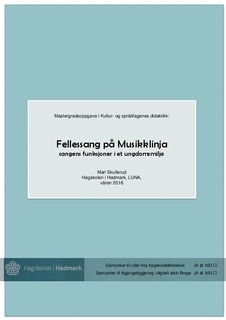Fellessang på Musikklinja – sangens funksjoner i et ungdomsmiljø.
Master thesis
Permanent lenke
http://hdl.handle.net/11250/2406830Utgivelsesdato
2016Metadata
Vis full innførselSammendrag
Norsk:
«Fellessang på Musikklinja – sangens funksjoner i et ungdomsmiljø» er en masteroppgave som utforsker korsang, allsang og andre former for fellessang på den videregående opplæringen Musikk, dans og drama. Problemstillingen for studiet er: Hvilke funksjoner har fellessang for elever på Musikklinja?
Det empiriske materialet ble samlet inn med etnografisk tilnærming gjennom observasjon av og intervjuer med elever på Musikklinja. Fokusområdet var på ulike former for fellessang, gjennom skoledagen. Dataene ble analysert og drøftet induktivt og deduktivt, og det teoretiske rammeverket for oppgaven var omhandlende ungdomskultur, musikalsk identitetsdannelse og musikkens funksjoner.
Funnene viser at fellessang fyller et mangfold av funksjoner som står i gjensidig relasjon til hverandre og utfyller hverandre. For å nå en analytisk forståelse av fenomenene kan fellessangens funksjoner deles opp i kategoriene ekspressiv funksjon, inntrykksfunksjon, undervisende og dannende funksjon, appellerende funksjon og hverdagsfunksjon. Disse funksjonene drøftes og ses i lys av hverandre og eksisterende teori. For å skape meningsfull musikkundervisning for elevene på Musikklinja, må disse funksjonene ses i relasjon til andre komponenter av utdanningen, så vel som elevenes musikkverdener også utenfor skolen. English:
“Joint singing at ‘Musikklinja’: The functions of singing in a youth culture” is a master’s thesis exploring the practices of choral, singalong and other forms of joint singing at the Norwegian “Programme for Music, Dance and Drama” at the upper secondary school level. Its main research question is: “What are the functions of joint singing at ‘Musikklinja’?”
The empirical data was collected through an ethnographic approach, observing and interviewing students at ‘Musikklinja’ over an extended period of time, and focusing on all the forms of joint singing that they engaged in during their everyday life at school. The data was analysed and interpreted using both inductive and deductive approaches, and the theoretical framework of the study was constructed leaning on theories of youth culture, the construction of musical identity and the functions of music.
The findings show that joint singing fulfils a multiplicity functions which interact in complex ways. Nevertheless, for the purpose of reaching an analytical understanding of the phenomenon, the functions of joint singing at ‘Musikklinja’ might be divided into five distinct areas: the expressive function; the function of impression; the educational and enculturating function; the appealing function; and the everyday function. In order for teachers to create meaningful music education for the ‘Musikklinja’ students, these functions must be understood in relation to the other components of the students' education as well as to the musical worlds that the students partake in outside of school.
Beskrivelse
Mastergradsoppgave i kultur- og språkfagenes didaktikk, Avdeling for lærerutdanning og naturvitenskap, Høgskolen i Hedmark, 2016.
